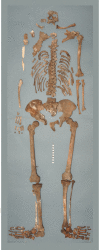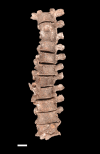Rich table but short life: Diffuse idiopathic skeletal hyperostosis in Danish astronomer Tycho Brahe (1546-1601) and its possible consequences
- PMID: 29672561
- PMCID: PMC5909615
- DOI: 10.1371/journal.pone.0195920
Rich table but short life: Diffuse idiopathic skeletal hyperostosis in Danish astronomer Tycho Brahe (1546-1601) and its possible consequences
Abstract
The exhumation of Danish astronomer Tycho Brahe (1546-1601) was performed in 2010 to verify speculative views on the cause of his death. Previous analyses of skeletal and hair remains recovered from his grave refuted the presumption that he died from poisoning. These studies also outlined the possibility that he actually died from an acute illness, echoing the rather vague and inaccurate testimony of some historical records. We performed a detailed paleopathological analysis of Tycho Brahe's skeletal remains, along with a reconstruction of his diet based on carbon and nitrogen stable isotopes analysis and an estimate of his physical status (relative body fat) based on medullar and cortical dimensions of the femoral shaft. The astronomer's remains exhibit bone changes indicative of diffuse idiopathic skeletal hyperostosis (DISH). The study further allows us to classify him as obese (100% reliability according to our decision tree designed from Danish males), and points out his rich diet (high input of animal protein and/or marine resources) and high social status. Comorbidities of DISH and obesity are reviewed, and their influence on health status is discussed. We further consider some conditions associated with metabolic syndrome as possible causes of Tycho Brahe's final symptoms (urinary retention, renal failure and coma), including diabetes, alcoholic ketoacidosis and benign prostatic hypertrophy. Although a definite and specific diagnosis cannot be established, our study points to today's civilization diseases often associated with DISH and metabolic syndrome as the possible cause of death of Tycho Brahe.
Conflict of interest statement
Figures







Similar articles
-
Diffuse idiopathic skeletal hyperostosis: Diagnostic, clinical, and paleopathological considerations.Clin Anat. 2016 Oct;29(7):870-7. doi: 10.1002/ca.22716. Epub 2016 Apr 18. Clin Anat. 2016. PMID: 27004482 Review.
-
A paleoepidemiologic study of diffuse idiopathic skeletal hyperostosis.Joint Bone Spine. 2000;67(3):210-4. Joint Bone Spine. 2000. PMID: 10875320
-
Diffuse idiopathic skeletal hyperostosis in ancient clergymen.Eur Spine J. 2007 Aug;16(8):1129-35. doi: 10.1007/s00586-007-0342-x. Epub 2007 Mar 28. Eur Spine J. 2007. PMID: 17390155 Free PMC article.
-
Facial approximation of Tycho Brahe's partial skull based on estimated data with TIVMI-AFA3D.Forensic Sci Int. 2018 Nov;292:131-137. doi: 10.1016/j.forsciint.2018.08.002. Epub 2018 Aug 9. Forensic Sci Int. 2018. PMID: 30296629
-
[Diffuse idiopathic skeletal hyperostosis in the dog (DISH): a review].Schweiz Arch Tierheilkd. 2016 May;158(5):331-9. doi: 10.17236/sat00061. Schweiz Arch Tierheilkd. 2016. PMID: 27518578 Review. German.
References
-
- Janovský I (2010) Tycho Brahe’s death: facts and speculations In: Hadravová A, Mahoney TJ, Hadrava P, editors. Kepler’s heritage in the space age (400th anniversary of Astronomia nova). Prague: National Technical Museum; pp. 126–135.
-
- Mikovec FB (1847) Tycho Brahe, Životopisný nástin–K třistaleté památce narození Tychona. Prague, J Pospíšil Press.
-
- Vellev J (2006) Tycho Brahes begravelse i Prag In: Grinder-Hansen P, editor. Tycho Brahes Verden Danmarki Europa 1550–1600 The World of Tycho Brahe. Copenhagen: The National Museum; pp. 229–243 (English summary, p. 277: ‘Tycho Brahe’s burial in Prague’).
-
- Gotfredsen E (1955) Tycho Brahe sidste sygdom og død [Tycho Brahe’s last illness and death]. Fund og Forskning 2: 33–38.
-
- Kučera J, Rasmussen KL, Kameník J, Kubešová M, Skytte L, Povýšil C, et al. (2017) Was He Murdered or Was He Not?—Part II: Multi‐Elemental Analyses of Hair and Bone Samples from Tycho Brahe and Histopathology of His Bones. Archaeometry 59, 5: 918–933.
Publication types
MeSH terms
LinkOut - more resources
Full Text Sources
Other Literature Sources
Molecular Biology Databases

